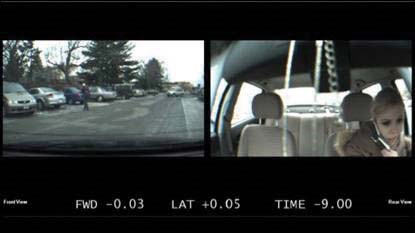
As a new report shows that distracted driving is a bigger cause of accidents than previously thought, Jon Masters asks what should be done to counter this problem.
Research carried out by the
The analysis shows it’s difficult to pin down any one type of influencing cause of the crashes; the use of cell phones attracts considerable public focus as an inherent danger, but mostly because it is a relatively new hazard. In its report the AAA found cell phone use was the cause in 12% of distracted teen driver crashes but interacting with passengers in the car was the biggest source of distraction, accounting for 15% of the teen crashes studied.
“Access to crash videos has allowed us to better understand the moments leading up to a vehicle impact in a way that was previously impossible,” says Peter Kissinger, the AAA Foundation’s president and CEO. “The in-depth analysis provides indisputable evidence that teen drivers are distracted in a much greater percentage of crashes than we previously realised.”
Study method
The AAA study made use of Ltyx’s
Data for the AAA study came from a teen driving program involving use of DriveCam. Ltyx made 6842 videos of teen crashes between August 2007 and July 2013, of which 1691 met inclusion criteria that excluded minor curb strikes and where the vehicle was struck from behind. The study is known not to include any data from fatal crashes.
What it reveals is an endemic problem of driver inattention noting that the driver contributed in some way to 94% of vehicle to vehicle crashes and 99% of single vehicle accidents. Recognition errors (inattention or inadequate surveillance) were a factor in 100% of road departure crashes with distraction from passengers and cell phone being the biggest causes.
Some of the videos can be viewed at: <%$Linker:
Federal response
The NHTSA estimates there are at least 3,000 deaths annually in ‘distraction-affected’ crashes – where a driver lost control due to a manual, visual or mental distraction.
“Ending distracted driving will take a combination of good laws, tough enforcement, and increased public awareness. If passed, the Grow America bill will enable more states to qualify for grants for funding distracted driving programs, including enforcement initiatives,” says an NHTSA spokesman.
“Whether it’s 16% or 58%, distraction is a serious, potentially deadly problem that is far too common on our roads. The AAA study uses significantly different methodology from our estimates, but it is a welcome contribution to our knowledge and we are glad that AAA and other organisations are speaking out about the seriousness of the issue.”
The single best solution, in Kissinger’s view, is graduated driver licensing (GDL) which a number of states have introduced to increase young drivers’ training and experience before they are given the full freedom of the road. Typically, under GDL laws, new drivers have to pass a written test and then spend time driving under the supervision of a parent or guardian to gain experience.
“The data shows that this is the safest they will be in the car at any point in their lifetime,” Kissinger says. “Further intermediate restrictions of GDL limit young drivers driving at night, how many passengers they can carry and ban use of mobile phones at any point.
“Against this backdrop, inspired by similar initiatives in Australia and elsewhere, US states that have introduced GDL have seen teen crashes drop by about 50%.”
The AAA commonly embarks on a campaign to alert state DOTs and others of its research results and in this case the crucial message is that 60% of teen crashes are due to inattention and distraction, with passengers the biggest cause.
“One passenger in the car increases the crash risk by 50%, two passengers doubles the risk. The AAA is aware of 18 states that have passenger restrictions in place. That means there are 32 others that could pass legislation tomorrow and reduce deaths by 50%. Hopefully state legislators will show the necessary courage and fortitude to take action and put similar laws in place,” says Kissinger.
A role for ADAS
Driver assistance technology could play a role in reducing distraction – or alerting drivers once they deviate from a given lane. Phone apps such as
The AAA has carried out analysis of six common advanced driver assistance systems (ADAS), including adaptive cruise control, forward collision warning, lane departure warning and autobrake. Partly what this report highlights is the difficulty encountered in evaluating the merits of ADAS, given the many other factors influencing crashes and a general lack of data to prove the technology makes much of a difference. The AAA report found substantial disparity between the claimed theoretical benefits and actual proven effectiveness.
“All of these technologies appear to have tremendous potential but in reality there isn’t enough real world experience of how it can help. The traditional lane departure warning system is the rumble strip on the side of the road - an audible electronic system or flashing light on the dashboard is not necessarily going to work as well,” says Kissinger.
There is also the likelihood that ADAS is mostly found in the high-spec end of most OEM’s vehicle range - which are generally not the vehicles that teens drive. Likewise, smartphone apps that disable the phone use in moving cars and technologies that allow parents to monitor their children’s driving are unlikely to be used by those that need it most.
“A study in California showed drivers behave better with cameras watching them and devices reporting the vehicle speed, which is encouraging but this was in a controlled environment. Insurance companies want to see this sort of technology and parents taking a proactive approach to their children’s safety, but the people likely to do this are not those we need to target,” Kissinger says.
The Insurance Institute for Highways Safety (IIHS) researched the benefits of in-vehicle voice systems for making or receiving calls compared with the use of hand-held phones. The results show a positive result, but not the elimination of distraction altogether, it reports.
Easier to use
“Ideally, drivers wouldn’t do anything but drive while the vehicle is moving. But people are increasingly plugged in at all times, and automakers have made it easier to use technology on the move,” says IIHS senior research scientist Ian Reagan. “While you can’t completely eliminate the distracting nature of these types of tasks, this study shows it’s possible to reduce some types of distraction through system design.”The AAA is currently benchmarking different in-vehicle voice systems on a five point scale after the IIHS found significant differences across vehicle manufacturers. “But the short answer is that hands free is not risk free,” says Kissinger.
“Research has shown that if a driver stops at a red light, texts somebody, then the lights change; that driver is still mentally distracted from concentrating on driving. Once the focus of concentration is elsewhere, you’re distracted so phones should be for emergency only.”
A study by the IIHS found that progress has slowed on developing the most effective elements of GDL. In recent years, most revisions to young driver laws have addressed cellphone use, while other provisions known to promote big safety benefits have seen little change, the IIHS reports.
GDL gradually introduces new teenage drivers to the driving task as they develop on-the-road skills. Typically GDL has three stages: learning under supervision, an intermediate license (after passing a road test) that limits driving in high-risk situations except under supervision, and a license with full privileges.
“The question lawmakers should ask themselves is, ‘have we done all that we can do to keep our youngest drivers safe on the road?’ In many cases, the answer is ‘no’,” says Anne McCartt senior vice president for research at IIHS and author of the latest GDL law study.
GDL laws vary considerably among states and current best practice includes a minimum intermediate license age of 17 in New Jersey and at least 70 hours of supervised practice in Maine. A night driving restriction during the intermediate stage applies from sunset in Idaho and 6pm in South Carolina while 15 states and DC ban teens from carrying teen passengers.






